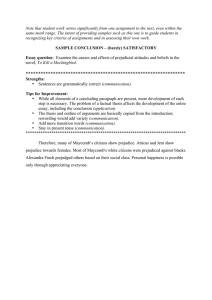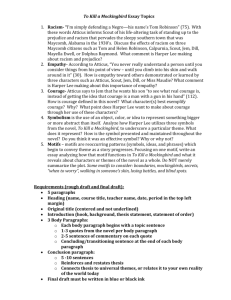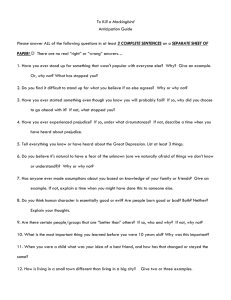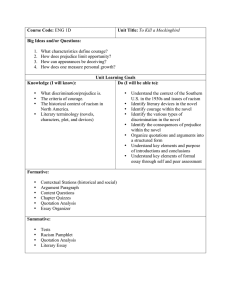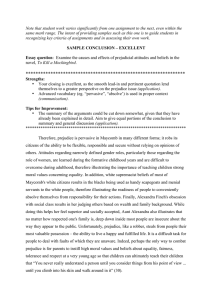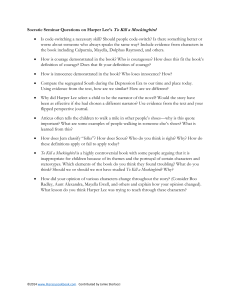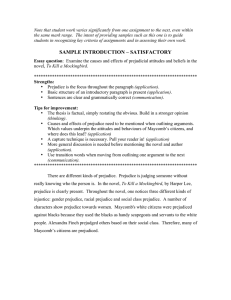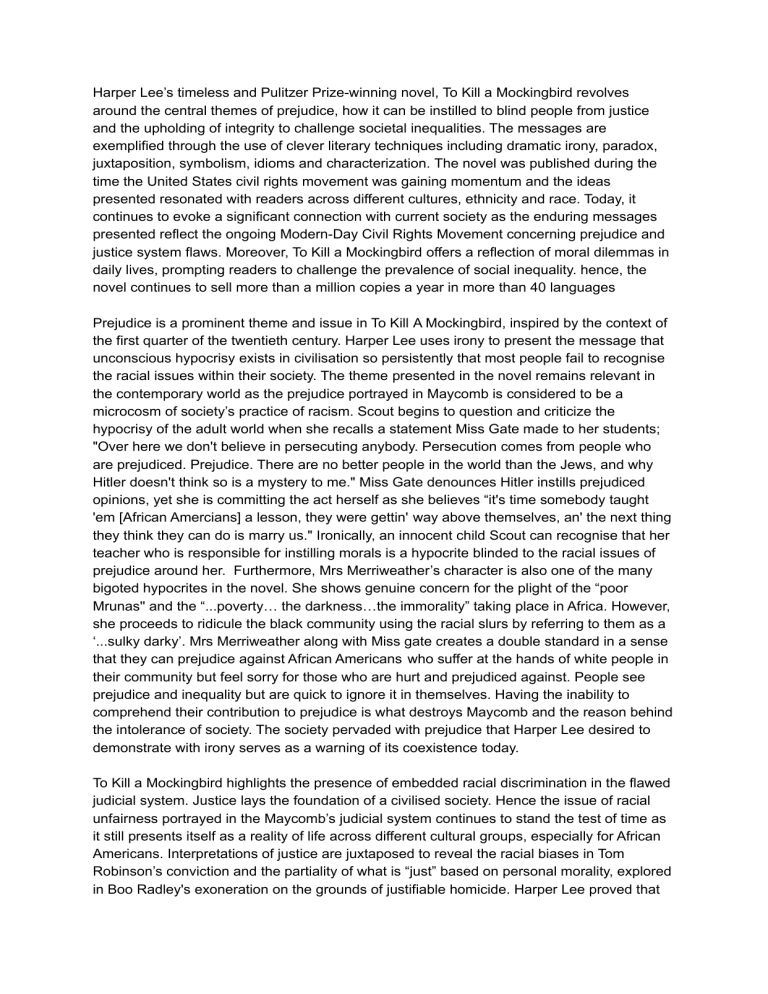
Harper Lee’s timeless and Pulitzer Prize-winning novel, To Kill a Mockingbird revolves around the central themes of prejudice, how it can be instilled to blind people from justice and the upholding of integrity to challenge societal inequalities. The messages are exemplified through the use of clever literary techniques including dramatic irony, paradox, juxtaposition, symbolism, idioms and characterization. The novel was published during the time the United States civil rights movement was gaining momentum and the ideas presented resonated with readers across different cultures, ethnicity and race. Today, it continues to evoke a significant connection with current society as the enduring messages presented reflect the ongoing Modern-Day Civil Rights Movement concerning prejudice and justice system flaws. Moreover, To Kill a Mockingbird offers a reflection of moral dilemmas in daily lives, prompting readers to challenge the prevalence of social inequality. hence, the novel continues to sell more than a million copies a year in more than 40 languages Prejudice is a prominent theme and issue in To Kill A Mockingbird, inspired by the context of the first quarter of the twentieth century. Harper Lee uses irony to present the message that unconscious hypocrisy exists in civilisation so persistently that most people fail to recognise the racial issues within their society. The theme presented in the novel remains relevant in the contemporary world as the prejudice portrayed in Maycomb is considered to be a microcosm of society’s practice of racism. Scout begins to question and criticize the hypocrisy of the adult world when she recalls a statement Miss Gate made to her students; "Over here we don't believe in persecuting anybody. Persecution comes from people who are prejudiced. Prejudice. There are no better people in the world than the Jews, and why Hitler doesn't think so is a mystery to me." Miss Gate denounces Hitler instills prejudiced opinions, yet she is committing the act herself as she believes “it's time somebody taught 'em [African Amercians] a lesson, they were gettin' way above themselves, an' the next thing they think they can do is marry us." Ironically, an innocent child Scout can recognise that her teacher who is responsible for instilling morals is a hypocrite blinded to the racial issues of prejudice around her. Furthermore, Mrs Merriweather’s character is also one of the many bigoted hypocrites in the novel. She shows genuine concern for the plight of the “poor Mrunas'' and the “...poverty… the darkness…the immorality” taking place in Africa. However, she proceeds to ridicule the black community using the racial slurs by referring to them as a ‘...sulky darky’. Mrs Merriweather along with Miss gate creates a double standard in a sense that they can prejudice against African Americans who suffer at the hands of white people in their community but feel sorry for those who are hurt and prejudiced against. People see prejudice and inequality but are quick to ignore it in themselves. Having the inability to comprehend their contribution to prejudice is what destroys Maycomb and the reason behind the intolerance of society. The society pervaded with prejudice that Harper Lee desired to demonstrate with irony serves as a warning of its coexistence today. To Kill a Mockingbird highlights the presence of embedded racial discrimination in the flawed judicial system. Justice lays the foundation of a civilised society. Hence the issue of racial unfairness portrayed in the Maycomb’s judicial system continues to stand the test of time as it still presents itself as a reality of life across different cultural groups, especially for African Americans. Interpretations of justice are juxtaposed to reveal the racial biases in Tom Robinson’s conviction and the partiality of what is “just” based on personal morality, explored in Boo Radley's exoneration on the grounds of justifiable homicide. Harper Lee proved that justice is a paradox when Tom Robinson was convicted for the sole reason he was of a different race than the majority. “Tom was a dead man the minute Mayella Ewell opened her mouth and screamed.” because “In our courts when it's a white man's word against a black man's, the white man always wins.” However, Jem Finch’s disagreement of what the jury believes is ‘just’ is juxtaposed with his statement; “Yessir, but the jury didn’t have to give him death… they could’ve given him twenty years.” Tom’s death was likened to the “senseless slaughter of a songbird”and the symbolism conveys that Tom is an innocent mockingbird killed by the injustice of bias, prejudice and corruption within the justice system. Additionally, the flaws of justice are further emphasized when Sheriff Heck Tate comments, “There’s a black boy [Tom Robinson] dead for no reason, and the man [Bob Ewell] responsible for it’s dead. Let the dead bury the dead this time, Mr Finch.” Ironically, the person responsible for reinforcing the justice system in society believes that Bob Ewell had been rightfully executed. In defiance to the justice gained for Tom Robinson, justice was demolished for Bob Ewell and his children. In Heck Tate’s opinion, true justice has been served but yet in the opinion of the USA and Atticus, justice was not served. Harper Lee had used an idiom with a figurative meaning to amplify the fact that two wrongs do not make one right. People chose to ignore evidence and the proper course of justice because it conflicts with their bigoted or biased morality. Society is still challenged with the compelling account of failing justice and the evils of racial prejudice. Harper Lee’s notion of blind justice in the novel seen in historical context is the continuing problems of the US justice system. Throughout the novel, Harper Lee explores the instances of physical and moral courage to instigate changes to the issues of prejudice within society. Courage remains an influential theme as the novel portrays it in a timeless dimension; choosing what to do that is right, even if doing so is difficult or guaranteed to fail. To Kill a Mockingbird expresses that notion through the use of symbolism and characterisation. During the 1930s, the South was a place of rules, traditions and societal expectations, individuals who challenged the ideology were prejudiced against. A moral and physical display of courage is exhibited when Atticus took a shot at the rabid dog with one shot to protect his neighbours, through the scene he demonstrated his courage by putting himself between two powerful opposing forces – innocence and danger. Atticus killed the dog without losing his morality as he "decided he wouldn't shoot till he had to, and he had to today." Symbolically Atticus was able to stop the “Maycomb’s usual disease of racism and prejudice” from spreading and he also displays physical courage when he waits outside of the county jail to protect Tom Robinson from a lynching mob so he may be able to partake in a trial. Additionally, Atticus displays moral courage in defending Tom Robinson despite knowing he will not win the trial. According to Atticus, “[courage is when] you're licked before you begin but you begin anyway and you see it through no matter what’. Atticus’s act of moral courage allowed the issue of racism in the justice system to be brought to light, his decision to persist in what he believes is right allowed Maycomb to take a step towards change. Harper Lee was able to disseminate the examples of courage that have the power to challenge the existing practice of prejudice and racism to create changes in behaviours. Thus, moral courage is considered to be a core value and a choice, regardless of the consequences as displayed in the novel. To Kill a Mockingbird revolves around the central themes of prejudice, how it can be instilled to blind people from justice and the upholding of integrity to challenge societal inequalities. The morality lessons encapsulated by To Kill a Mockingbird remain enduring, especially during the current generation with rising of racial intolerance and prejudice against subjugated races. In society, prejudiced beliefs are instilled to blind people from justice, overcoming the problem requires moral courage as displayed by Atticus. Through the use of dramatic irony, paradox, juxtaposition, symbolism, idioms and characterization, Harper Lee effectively creates a parallel between the problems within Maycomb and real life. Despite the novel’s events and characters belonging to the past. The novel embodies moral standards that many aspire to have and issues many aspire to overcome.
